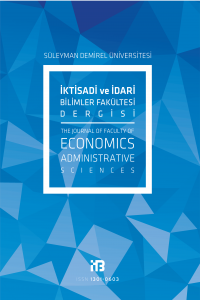BLACK BOX APPLICATION IN PUBLIC TRANSPORTATION AS AN INTELLIGENT TRANSPORT SYSTEM AND THE RESULTS OF DRIVER PERFORMANCE: THE CASE OF ISTANBUL ELECTRICITY, TRAM- WAY AND TUNNEL ADMINISTRATION (IETT) BLACK BOX PROJECT
Intelligent Transportation Systems, Public Transportation, Personnel Management, IETT, Black Box Project
AKILLI ULAŞIM SİSTEMİ OLARAK TOPLU ULAŞIMDA KARAKUTU UYGULAMASI VE ŞOFÖR PERFORMANS SONUÇLARI: İSTANBUL ELEKTRİK TRAMVAY VE TÜNEL İŞLETMELERİ (İETT) KARAKUTU PROJESİ ÖRNEĞİ
Akıllı Ulaşım Sistemleri, Toplu Ulaşım, Personel Yönetimi, İETT, Karakutu Projesi,
___
- TURK F1. AdBlue Nedir, What is Ad-Blue, http://www.turkf1.com/Hbr-2844-AdBlue-nedir-bittiginde-eklenmezse-ne-olur.html, 10.10.2017.
- BENSGHİR, T. K. and DEMİRCİ, F. (2017). “Rethinking Posdcorb From Government to Network Governance in Digitalizing Public Organizations”, pp. 384-387, (Eds.) OKÇU, M. and GÜL, H., KAYFOR 15 Book of Abstracts Pub-lic Administration and Policy in Digital Age, Süleyman Demirel University, Isparta.
- CAMBRIDGE DICTIONARY (2017). What is Black Box, http://dictionary.cambridge.org/dictionary/english/black-box, 01.09.2017.
- CASCETTA, E. and CARTENI, A. (2014). “A Quality-Based Approach to Public Transportation Planning: Theory and a Case Study”, International Jour-nal of Sustainable Transportation, 8 (1), pp. 84-106.
- ÇELİKYAY, H. (2012). “Tarihin Derin-liklerinden Küresel Güce Değişim, Bir Zümrüdüanka: İstanbul”, Yerel Poli-tikalar Dergisi, 2, pp. 148-153.
- ÇELİKYAY, H. H. (2017). “The Stud-ies Through Smart Cities Model: The Case of Istanbul”, International Journal of Research in Business and Social Sci-ence 6(1), pp. 149-163.
- COCCHIA, A. (2014). “Smart and Digital City: A Systematic Literature Review”, pp. 13-43, (Eds.) DAMERI, R. P. and C. ROSENTAL – SA-BROUX, Smart City, Progress in IS, Springer International Publishing, Switzerland.
- EUROPEAN SMART CITIES, http://www.smart-cities.eu/?cid=1&ver=4, 10.08.2017.
- HOUGH, J. A. BAHE, C., MURPHY, M. L., SWENSON, J. (2002). Intelligent Transportation Systems: Helping Public Transit Support Welfare To Work Initia-tives, Upper Great Plains Transportation Institute, North Dakota State University, Fargo N. D. 58105. https://www.mountain-plains.org/pubs/pdf/MPC02-131.pdf.
- HUWAEI TECHNOLOJIES CO. (2016). Smart Transportation Maximize Mobile Network’s Value Beyond Con-nectivity Report, http://www-file.huawei.com/~/media/CORPORATE/PDF/white%20paper/smart-transportation.pdf.
- İETT, İstanbul Elektrik Tramvay ve Otobüs İşletmeleri, iett.gov.tr, 05.08.2017.
- MANVILLE, C., COCHRANE, G., CAVE, J. MILLARD, PEDERSON, J. K. THAARUP, R. K., LIEBE, A., WISSNER, M., MASSINK, R. and KOTTERINK, B. (2014). Mapping Smart Cities in Europe, European Par-liament, Directorate General For Inter-nal Policies, http://www.europarl.europa.eu/RegData/etudes/etudes/join/2014/507480/IPOL-ITRE_ET(2014)507480_EN.pdf
- MONATY, S. P., CHOPPALI, U. and KOUGIANOS, E. (2016). “Everything you Wanted to Know about Smart Cit-ies: The Internet of Things is the Back-bone”, IEEE Consumer Electronics Magazine, 5(3), pp. 60-70.
- NAGAPPAN, G. and CHELLAPAN, C. (2009). “Smart Transportation System”, International Journal of Computer Sci-ence And Applications, 2(1).
- SMART CITIES COUNCIL, Smart City Components, http://smartcitiescouncil.com/tags/smart-city-components, 05.08.2017.
- STEFANSSON, G. and LUMSDEN, K. (2008). “Performance issues of Smart Transportation Management”, Interna-tional Journal of Productivity and Per-formance Management, 58(1), pp.55-70.
- TDK, Türk Dil Kurumu, tdk.gov.tr, 05.08.2017.
- TKM, İstanbul Büyükşehir Belediyesi Trafik Kontrol Merkezi, tkm.ibb.gov.tr, 30.07.2017.
- UCLG United Cities Local Govern-ments (2012). Smart Cities Study: Inter-national Study on the Situation of ICT, Innovation and Knowledge in Cities. Bilbao.
- STADT WIEN, Smart City, (https://www.wien.gv.at/stadtentwicklung/studien/pdf/b008403j.pdf, 03.08.2017.
- YOKOTA, T., (2004). “ITS for Devel-oping Countries”, Technical Note 1, http://siteresources.worldbank.org/INTTRANSPORT/214578-1097078718496/20281380/ITS%20Note%201.pdf.
- ZANELLA A., BUI, N., CASTELLA-NI, A., VANGELISTA, L., and ZORZI, M. (2014). “Internet of Things for Smart Cities”, IEEE Internet of Things Jour-nal, 1(1).
- ISSN: 1301-0603
- Yayın Aralığı: Yılda 3 Sayı
- Başlangıç: 1996
- Yayıncı: Süleyman Demirel Üniversitesi
Oral KARAKAYA, Kaan GAYTANCIOĞLU
AVRUPA BİRLİĞİ’Nİ DEĞİŞİME ZORLAYAN GÜÇ: GÖÇ
AVRUPA BİRLİĞİ AKILLI KENT UYGULAMALARI VE TÜRKİYE’DEKİ YANSIMALARI
Ahmet UÇAR, Nilüfer NEGİZ, Sühal ŞEMŞİT
Ahmet TUNÇ, Aziz BELLİ, Abdullah AYDIN
PANOPTİKON: DEMOKRASİ EKSENİNDE REALİTEDEN KURGUSALA DOĞRU BİR BAKIŞ
SU VE KANALİZASYON İDARELERİNDE AKILLI SU YÖNETİMİ UYGULAMALARI: TEKİRDAĞ ÖRNEĞİ
SOSYAL MEDYA ÜZERİNDE VERİ ANALİZİ: TWITTER
Mehmet ALBAYRAK, Kamil TOPAL, Volkan ALTINTAŞ
SANAL MEKÂNDA YEREL ÇEVRE HAREKETLERİ: TÜRKİYE’DE HES KARŞITI MÜCADELELER ÜZERINE BIR İNCELEME
